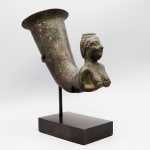Comic Rhyton, perhaps depicting a Siren, Fourth Century BC
Bronze
15.5 x 6 x 19.5 cm
6 1/8 x 2 3/8 x 7 5/8 in
6 1/8 x 2 3/8 x 7 5/8 in
CC.38
Further images
-
(View a larger image of thumbnail 1
)

-
(View a larger image of thumbnail 2
)

-
(View a larger image of thumbnail 3
)

-
(View a larger image of thumbnail 4
)

-
(View a larger image of thumbnail 5
)

-
(View a larger image of thumbnail 6
)

-
(View a larger image of thumbnail 7
)

-
(View a larger image of thumbnail 8
)

-
(View a larger image of thumbnail 9
)

-
(View a larger image of thumbnail 10
)

The symposion, the Classical Greek drinking party, was a time when the elite youth of Ancient Athens and other Greek poleis, could safely engage with the exotic, the sensual, and...
The symposion, the Classical Greek drinking party, was a time when the elite youth of Ancient Athens and other Greek poleis, could safely engage with the exotic, the sensual, and the risqué. In this ritualized format, specific vessels had specific purposes, to do with the mixing and serving of wine. It is to this context that most Greek pottery can be attributed. But there were also irregular forms, in pottery and in other materials, that originate in the symposion. One such form is the rhyton. The rhyton, or drinking horn, was a consciously Persian design; its arrival in Greece following the end of the Persian War can probably be attributed to the dominant Greeks co-opting the forms of the vanquished Persians. Rhyta came in two varieties; one as a regular drinking horn, and the other as a kind of funnel through which a thin stream could be drunk. Achaemenid, and then Greek, rhyta finish in protomes taking animal or human forms.
This rhyton is a mid-sized, sturdy form, finishing in a protome in the form of a female, with a short braided hairstyle, and a flat-topped Achaemenid headdress with a beaded diadem. She has wide, almond-shaped eyes, a pointed nose, and a playful smile. She wears a collar necklace and unusual star-shaped earrings. Her relatively broad shoulders lead down to a pair of pendulous breasts; she cups her breasts with her hands, squeezing around the prominent nipples. The image is altogether comic, fitting perfectly with the raucous, sexualised, atmosphere of the symposion. It is possible that this figure represents a Siren, the half-human, half-bird creatures whose song and sexual allure drew sailors onto the rocks. Mythological figures in comic settings were a common theme of sympotic pottery, and so this would fit both with purpose and setting. Her Persian headdress and short hairstyle served to mark her out as an exotic. The symposion was a safe space in which themes of the exotic could be explored without compromising the ideals of the polis.
A clear expression of the sensuality and exoticism of the symposion, this rhyton connects us to two of the characteristic passions of Ancient Greece: wine and women. It gives us a glimpse into the lives of elite young men, flirting with the exotic, engaging with raucous comic genres, and drinking as members of the exclusive sympotic clubs.
This rhyton is a mid-sized, sturdy form, finishing in a protome in the form of a female, with a short braided hairstyle, and a flat-topped Achaemenid headdress with a beaded diadem. She has wide, almond-shaped eyes, a pointed nose, and a playful smile. She wears a collar necklace and unusual star-shaped earrings. Her relatively broad shoulders lead down to a pair of pendulous breasts; she cups her breasts with her hands, squeezing around the prominent nipples. The image is altogether comic, fitting perfectly with the raucous, sexualised, atmosphere of the symposion. It is possible that this figure represents a Siren, the half-human, half-bird creatures whose song and sexual allure drew sailors onto the rocks. Mythological figures in comic settings were a common theme of sympotic pottery, and so this would fit both with purpose and setting. Her Persian headdress and short hairstyle served to mark her out as an exotic. The symposion was a safe space in which themes of the exotic could be explored without compromising the ideals of the polis.
A clear expression of the sensuality and exoticism of the symposion, this rhyton connects us to two of the characteristic passions of Ancient Greece: wine and women. It gives us a glimpse into the lives of elite young men, flirting with the exotic, engaging with raucous comic genres, and drinking as members of the exclusive sympotic clubs.









